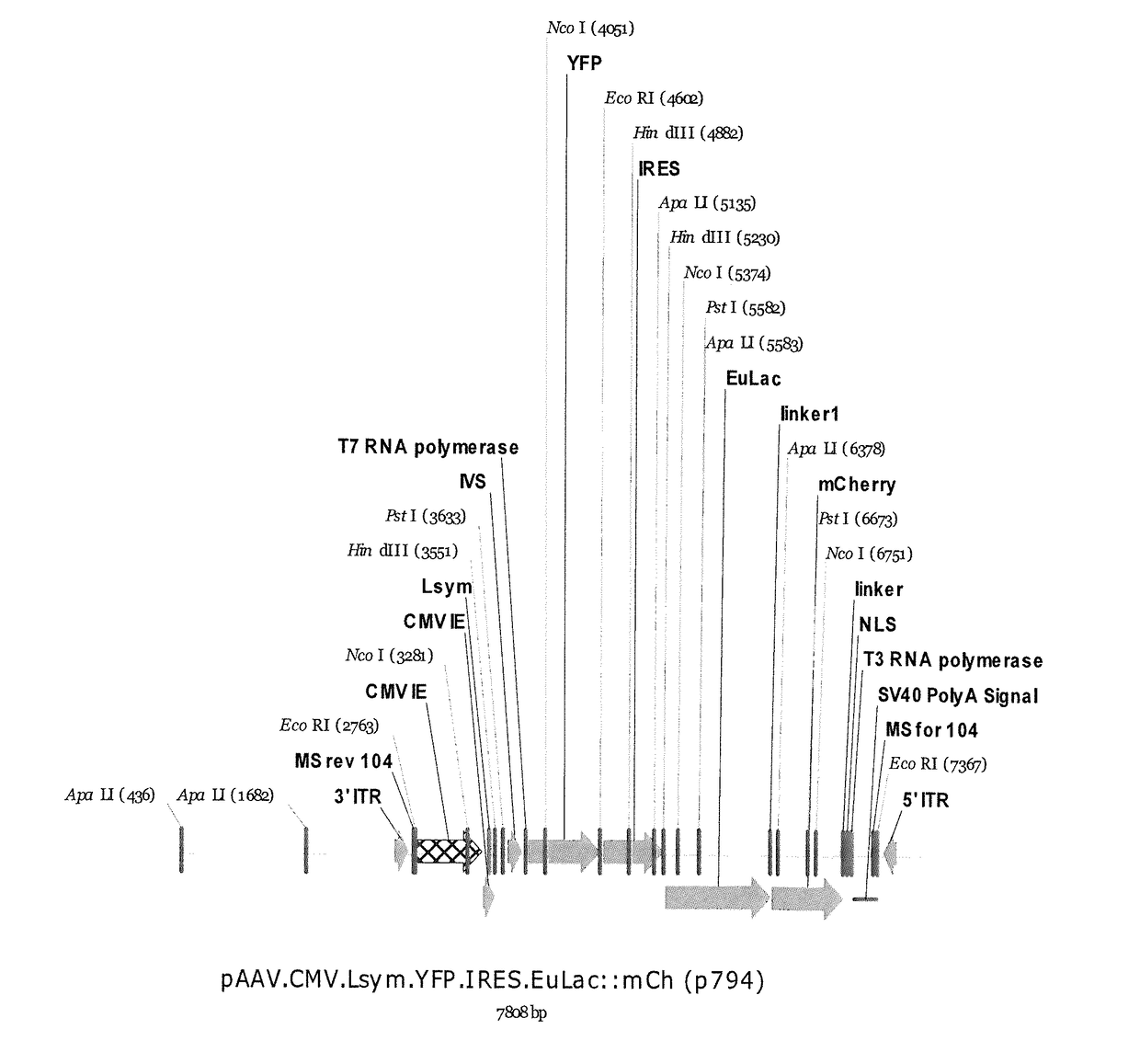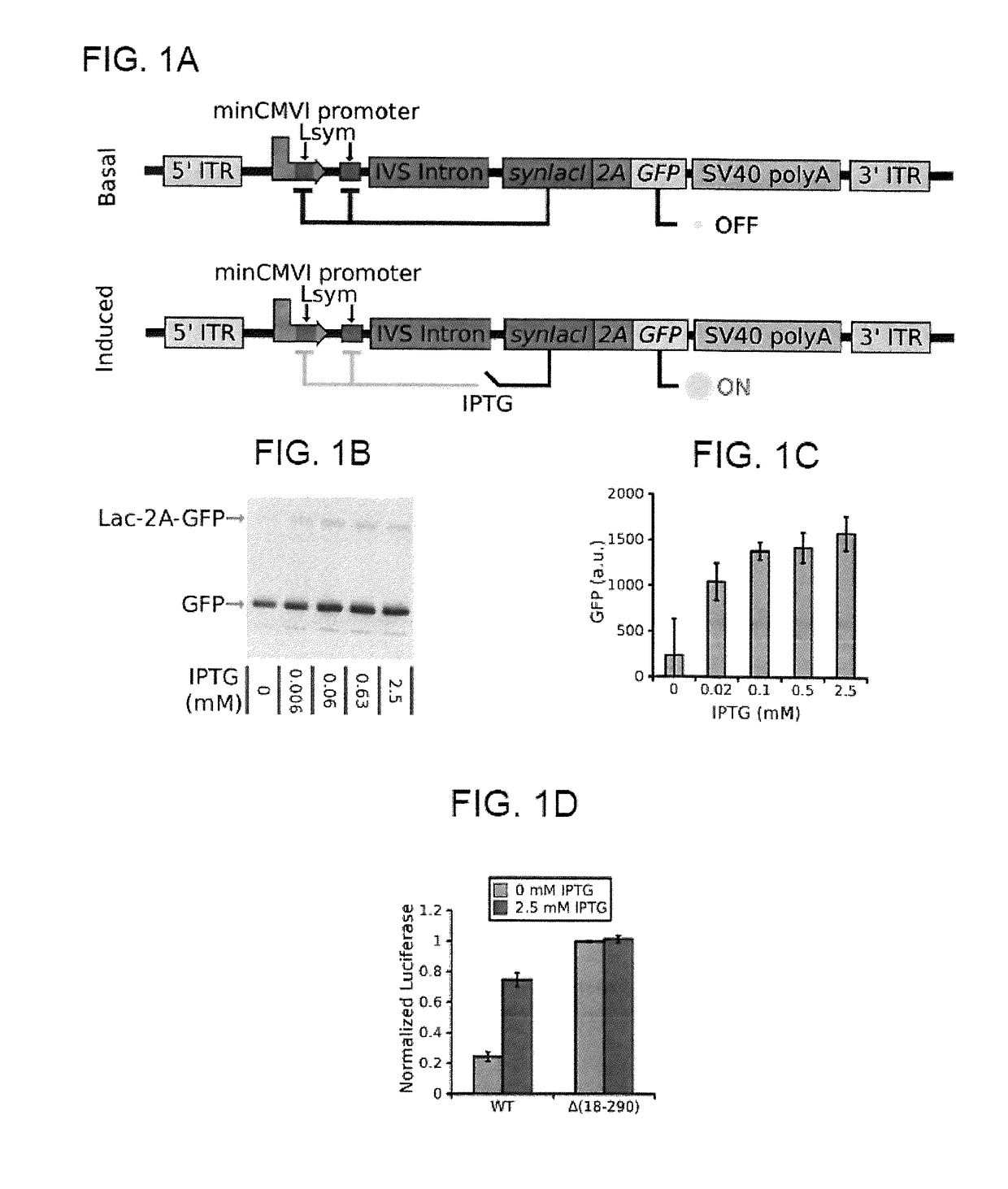Compositions and methods for self-regulated inducible gene expression
a technology of inducible gene expression and composition, applied in the field of self-regulated inducible gene expression, can solve the problems of unresolved obstacles, toxic, undesirable side effects, death, etc., and achieve the effect of reducing or inhibiting the expression of its own further expression, stably expressed, and tight regulation
- Summary
- Abstract
- Description
- Claims
- Application Information
AI Technical Summary
Benefits of technology
Problems solved by technology
Method used
Image
Examples
example 1
nd Materials
[0168]Bacterial Strains and Media
[0169]The strain EPB229 (E. coli F-λ-ilvG-rfb-50 rph-1Δ(lacI-lacA)::frt) was used for prokaryotic GFP regulation assays. This strain was made by the laboratory of Dr. Mark Goulian and derived from MG1655 (E. coli F-λ-ilvG-rfb-50 rph-1). This strain is the “wild-type” K-12 strain and has a total deletion of the lacI operon allowing for a clean background within which to study our lacI genetic regulatory systems. Liquid media for GFP regulation assays with EPB229 cells used MOPS minimal media supplanted with 0.4% glucose and 50 μg / mL kanamycin.
[0170]Eukaryotic Cell Lines and Media
[0171]The following cell lines were used for eukaryotic GFP and luciferase regulation assays and also in microscopy: The cell line HEK293T is derived from human embryonic kidney cells and stably expresses the Simian Vacuolating Virus (SV40) which codes for the large T-antigen. The cell line Cos-7 was derived from the African green monkey Cercopithecus aethiops fibr...
example 2
Transgene Regulatory Systems (ITRS)
[0228]An ITRS was constructed for use in AAV using the control elements of the bacterial lacI operon. We have demonstrated that the allosteric properties of the lacI repressor can be tuned to improve transgene regulation. The repressor binds tightly to its operator as well as cooperatively to ancillary sites which can potentially lower basal levels of expression.
[0229]A variety of switches were studied. We first made an autogenously regulated lacI genetic switch by placing the lacI gene fused to mCherry after the natural lacI promoter. A reporter gene, YFP, was included after an 18 base pair spacer. Prokaryotes are capable of expressing a poly-cistronic message where multiple genes are expressed off of a single promoter (which is how the lacZ, lacY, and lacA genes are naturally expressed), therefore we expected this single plasmid to make both a lacI repressor-mCherry fusion protein and the YFP reporter gene. The native lacZ / Y / A promoter under cont...
example 4
n Autogenously Regulated lacI Genetic Switch in Mammalian Cells
[0240]Next we established that the lac autogenous switch appropriately regulates gene expression in mammalian cells. We used a lac repressor gene (synlacI) which has been demonstrated to be capable of constitutive regulation in mice15,30. This gene includes a C-terminal nuclear localization sequence (NLS) to target the repressor to the nucleus. We verified that the lac repressor correctly localized to the nucleus by fusing mCherry to the C-terminus and visualizing mCherry localization through fluorescent microscopy (figure not shown). We next created a minimal length autogenous regulatory cassette for use in AAV (FIG. 1A). It is capable of accommodating a transgene up to approximately 2400 base pairs in an AAV vector. This cassette has the minimal CMV with a symmetric lac operator (Lsym) between the TATA box and the transcription start site and a second Lsym placed 92 base pairs downstream in order to facilitate cooperat...
PUM
| Property | Measurement | Unit |
|---|---|---|
| volume | aaaaa | aaaaa |
| volume | aaaaa | aaaaa |
| volume | aaaaa | aaaaa |
Abstract
Description
Claims
Application Information
 Login to View More
Login to View More - R&D
- Intellectual Property
- Life Sciences
- Materials
- Tech Scout
- Unparalleled Data Quality
- Higher Quality Content
- 60% Fewer Hallucinations
Browse by: Latest US Patents, China's latest patents, Technical Efficacy Thesaurus, Application Domain, Technology Topic, Popular Technical Reports.
© 2025 PatSnap. All rights reserved.Legal|Privacy policy|Modern Slavery Act Transparency Statement|Sitemap|About US| Contact US: help@patsnap.com



